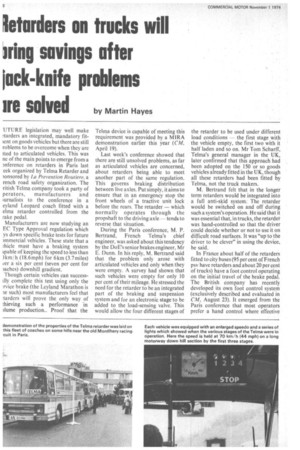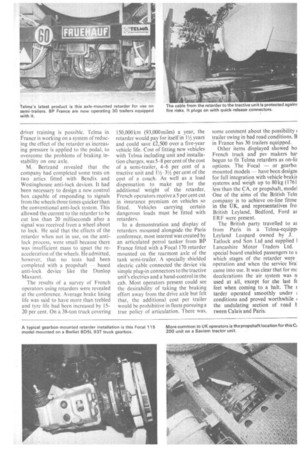Iletarders on trucks will king savings after jack-knife problems ire solved by ..„...yes
Page 30

Page 31

If you've noticed an error in this article please click here to report it so we can fix it.
UTURE legislation may well make ;tarders an integrated, mandatory fitlent on goods vehicles but there are still roblems to he overcome when they are tted to articulated vehicles. This was ne of the main points to emerge from a pnference on retarders in Paris last cek organized by Telma Retarder and )onsored by La Prevention Routiere, a rench road safety organization. The ritish Telma company took a party of perators, manufacturers and tirnalists to the conference in a eyland Leopard coach fitted with a elma retarder controlled from the rake pedal.
Manufacturers are now studying an EC Type Approval regulation which ys down specific brake tests for future mmercial vehicles. These state that a ihicle must have a braking system tpable of keeping the speed to less than )km/ h (18.6mph) for b km (3.7 miles) ver a six per cent (seven per cent for )aches) downhill gradient.
Though certain vehicles can successilly complete this test using only the Tvice brake (the Leyland Marathon is le such) most manufacturers feel that Tarders will prove the only way of thieving such a performance -in )1urne production.. Proof that the Telma device is capable of meeting this requirement was provided by a MIRA demonstration earlier this year (CM, April 19).
Last week's conference showed that there are still unsolved problems, as far as articulated vehicles are concerned, about retarders being able to meet another part of the same regulation. This governs braking distribution between live axles. Put simply, it aims to ensure that in an emergency stop the front wheels of a tractive unit lock before the rears. The retarder — which normally operates through the propshaft to the driving axle — tends to reverse that situation.
During the Paris conference, M. P. Bertrand, French Telma's chief engineer, was asked about this tendency by the DoE's senior brakes engineer, Mr E. Dunn. In his reply, M. Bertrand said that the problem only arose with articulated vehicles and only when they were empty. A survey had shown that such vehicles were empty for only 10 per cent of their mileage. He stressed the need for the retarder to be an integrated part of the braking and suspension system and for an electronic stage to be added to the load-sensing valve. This would allow the four different stages of the retarder to be used under different load conditions the first stage with the vehicle empty, the first two with it half laden and so on. Mr Tom Scharff, Telma's general manager in the UK, later confirmed that this approach had been adopted on the 150 or so goods vehicles already fitted in the UK, though all these retarders had been fitted by Telma, not the truck makers.
M. Bertrand felt that in the longer term retarders would be integrated into a full anti-skid system: The retarder would be switched on and off during such a system's operation. He said that it was essential that, in trucks, the retarder was hand-controlled so that the driver could decide whether or not to use it on difficult road surfaces. It was "up to the driver to be clever" in using the device, he said.
In France about half of the retarders fitted to city buses (95 per cent of French psv have retarders and about 20 per cent of trucks) have a foot control operating on the initial travel of the brake pedal. The British company has recently developed its own foot control system (exclusively described and evaluated in CM, August 23). It emerged from the Paris conference that most operators prefer a hand control where effective driver training is possible. Telma in France is working on a system of reducing the effect of the retarder as increasing pressure is applied to the pedal, to overcome the problems of braking instability on one axle.
M. Bertrand revealed that the company had completed some tests on two artics fitted with Bendix and Westinghouse anti-lock devices. It had been necessary to design a new control box capable of responding to signals from the wheels three times quicker than the conventional anti-lock system. This allowed the current to the retarder to be cut less than 20 milliseconds after a signal was received from a wheel about to lock. He said that the effects of the retarder when not in use, on the antilock process, were small because there was insufficient mass to upset the reacceleration of the wheels. He admitted, however, that no tests had been completed with a propshaft based anti-lock device like the Dunlop Maxaret.
The results of a survey of French operators using retarders were revealed at the conference. Average brake lining life was said to have more than trebled and tyre life had been increased by 1520 per cent. On a 38-ton truck covering
150,000 km (93,000 miles) a year, the retarder would pay for itself in 11/2 years and could save £2,500 over a five-year vehicle life. Cost of fitting new vehicles with Telma including unit and installation charges, was 5-8 per cent of the cost of a semi-trailer, 4-6 per cent of a tractive unit and 11/2-31/2 per cent of the cost of a coach, As well as a load dispensation to make up for the additional weight of the retarder, French operators receive a 5 per cent cut in insurance premium on vehicles so fitted. Vehicles carrying certain dangerous loads must be fitted with retarders.
In a demonstration and display of retarders mounted alongside the Paris conference, most interest was created by an articulated petrol tanker from BE France fitted with a Focal 170 retarder mounted on the rearmost axle of the tank semi-trailer. A specially shielded electric cable connected the device via simple plug-in connectors to the tractive unit's electrics and a hand-control in the cab. Most operators present could see the desirability of taking the braking effort away from the drive axle but felt that, the additional cost per trailer would be prohibitive in fleets pursuing a true policy of articulation. There was, some comment about the possibility trailer swing in bad road conditions. B in France has 30 trailers equipped.
Other items displayed showed ho French truck and psv makers ha, begun to fit Telma retarders as on-lit options. The Focal — or gearbo: mounted models have been design( for full integration with vehicle brakir systems and weigh up to 80 kg (1761 less than the CA, or propshaft, model One of the aims of the British Telt" company is to achieve on-line fitme in the UK, and representatives fro British Leyland, Bedford, Ford ar ERF were present.
The British party travelled to at from Paris in a Telma-equippi Leyland Leopard owned by J. Tatlock and Son Ltd and supplied 1 I .aneashire Motor Traders Ltd. special board enabled passengers to s which stages of the retarder were operation and when the service bral came into use. It was clear that for mc decelerations the air system was n used at all, except for the last ft feet when coming to a halt. The r tarder operated smoothly under conditions and proved worthwhile the undulating section of road t tween Calais and Paris.






























































































